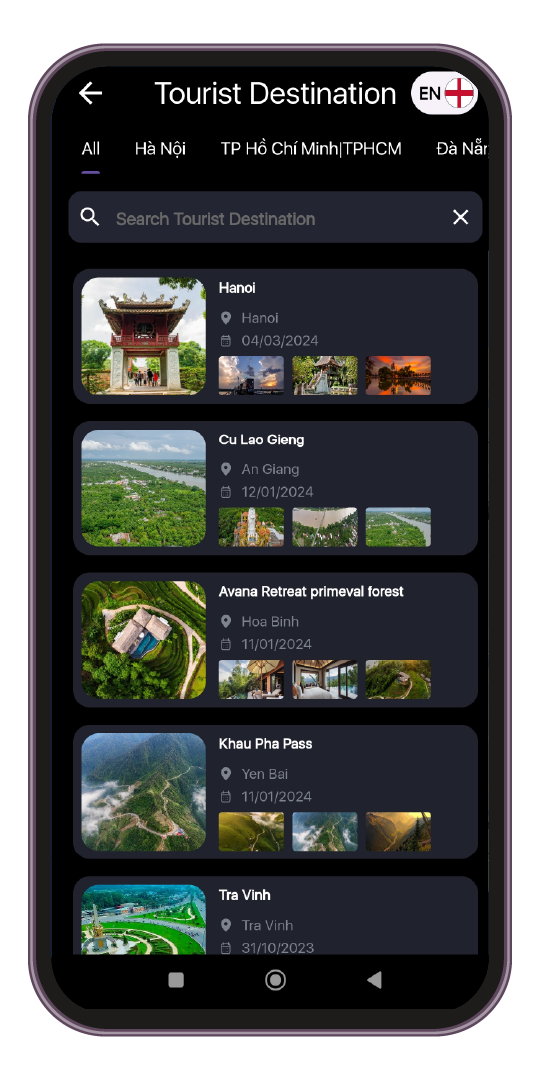The Pac Bo historical relic complex is located in Truong Ha commune, Ha Quang district, Cao Bang province. According to the Tay - Nung ethnic language, Pac Bo means "watershed". This is the place chosen by Uncle Ho as the revolutionary leadership base and is the place with an important mark in the nation's resistance war against the French and the Americans. Experiencing important milestones after all these years, this place still retains almost intact the evidence and imprints of the revolution and of President Ho. Pac Bo Cao Bang is covered with rugged mountains, beckoning waterfalls, and cool green bamboo groves throughout the sky. In addition to the beautiful scenery of the country, visitors can visit historical places such as Lenin stream, Karl Marx Mountain, President Ho Chi Minh memorial, Pac Po cave... Exploring the Pac Bo Cao Bang historical relic site, visitors will be immersed in the mysterious wild natural space and feel the historical and cultural values of this land. In the past, Lenin Stream was called Khuoi Giang stream by the villagers, which in the Tay language means heavenly stream, but in 1941, when Uncle Ho returned to the country and chose Pac Bo cave to live and work, he named this stream Lenin stream. Lenin Stream is located in the Pac Bo Cao Bang historical relic site, famous for its clear blue water that can be seen at the bottom like a mirror reflecting the great landscape of heaven and earth, creating a beautiful landscape. This destination is loved by many people because of its quiet space and poetic and lyrical scenery. There really is no beautiful word that can describe the beauty and purity of the Lenin stream. As history passes, this stream still retains its full beauty and increasingly attracts tourists because of the loving and graceful beauty of the water. Coming here, visitors will feel the place where Uncle Ho once lived, feel his warmth, and see the scenes that he was attached to during the resistance period. A destination not to be missed when coming to Pac Bo Cao Bang is Cac Mac Mountain. Along with the Lenin Stream, Karl Marx Mountain was also named by Uncle Ho. These are the names of the two thinkers who had the greatest influence on Uncle Ho's revolutionary career. Karl Marx Mountain has deep green forests with open terrain inside but is dangerous and secret outside. Perhaps because of such terrain, Uncle Ho chose it as a place for secret operations. Near the edge of Cac Mac mountain, along the Lenin stream, visitors will see the bamboo garden that Uncle Ho planted still exists. Everything seems to create a peaceful, poetic space for the place where Uncle Ho once stopped. "In the morning go to the stream, at night go to the cave" Uncle Ho's poem in the poem Pac Bo Scene describes Uncle Ho's daily life when he worked in Pac Bo Cao Bang. Pac Bo Cave, also known as Coc Po Cave, is only about 15 square meters wide. It is where he lived and worked when he first returned to the country. This is a place that contains many of his imprints. In the Cave, there is a wooden counter where Uncle Ho rested, a fire to warm himself, an unsteady stone table where people worked, or a stone made of Uncle Ho's size to sit fishing next to the Lenin stream, a bamboo garden next to the cave that Uncle Ho personally planted... all of it. are still there, and have become important historical markers of the Pac Bo historical site. Coming to the Pac Bo historical site, don't forget to visit Uncle Ho's temple located on Tieng Chit hill. The temple was built in May 2011 on the occasion of Uncle Ho's 121st birth anniversary. The temple was built in a stilt house style that is extremely close and familiar to the ethnic people here. This is not only a tourist destination for many domestic and foreign tourists, but also has historical and cultural value and shows respect and sacred affection for Uncle Ho - the man who devoted himself to the world. for the independence of the nation. Pac Bo Cao Bang is a charming place, every season has its own beauty. However, if you want to see the full beauty of this place, you should choose to come from October to May. At this time the weather is cool, not too cold nor too hot, and the weather is dry and convenient for traveling. Pac Bo's bumpy mountain roads. Especially, you can fully admire the poetic beauty of Lenin stream. Lenin Stream is famous for its beautiful turquoise water color, but during the year there will be about 2-3 months of rainy season (from July to September), the water flows so the water surface will not be clear, making it difficult to enjoy. enjoy the warm, poetic beauty of the place where Uncle Ho's footsteps were once imprinted.
Cao Bang 1611 view From January to December
Ngày cập nhật : 07/03/2023


 vn
vn en
en ja
ja ko
ko zh
zh




















































































































































